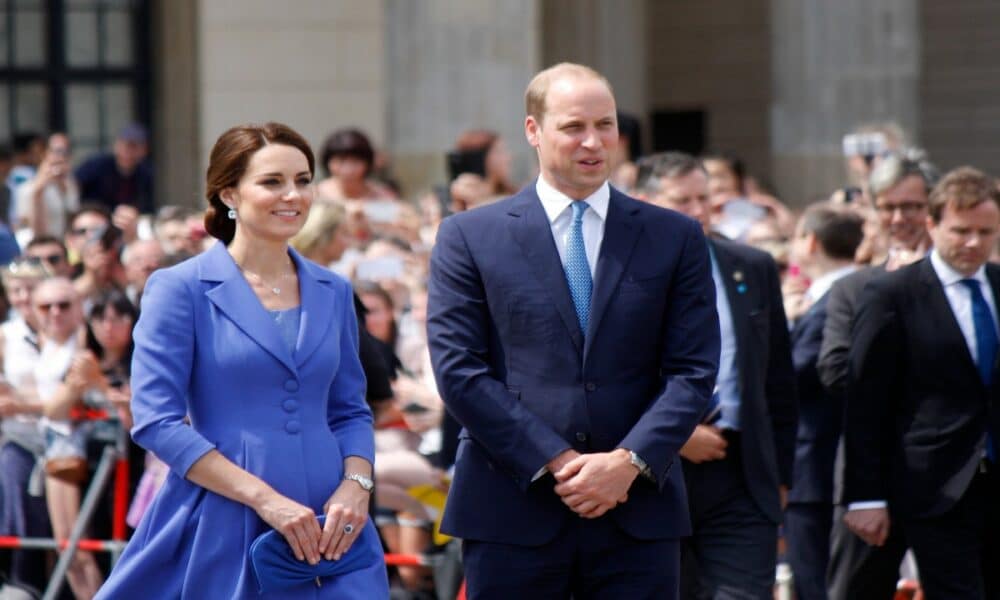challenges and accelerated preparation for the British throne amid King Charles III’s health problems
Behind the scenes of the British monarchy, Prince William and Kate Middleton are preparing for their future roles as king and queen. The year 2024 brought significant changes to the royal family, highlighting health challenges faced by King Charles III and Kate herself. The urgency of a well-planned transition has become clear as both navigate personal medical issues while focusing on the continuity of the monarchy. This scenario offers the public a deeper understanding of the pressures and responsibilities awaiting William and Kate on their path to the throne.
At 75 years old, King Charles III faced a diagnosis of prostate cancer, a condition that, while manageable, has significantly impacted his schedule. Meanwhile, Kate Middleton, aged 42, battled cancer after an abdominal surgery in January 2024. Despite these personal battles, the couple has demonstrated resilience, sharing responsibilities and earning public admiration for their handling of this transitional period.
The royal succession, a subject of public and political interest, now unfolds amid adversity. William has taken on an increasing number of duties traditionally handled by his father. These steps underscore the importance of careful planning and solid strategies to ensure the monarchy’s stability during inevitable changes.
Health Challenges in the British Monarchy
The health of royal family members has always been a sensitive and widely discussed issue. In February 2024, King Charles III was diagnosed with prostate cancer, a condition that required him to scale back his royal duties. This diagnosis highlighted the need for William to step up and represent the crown at national and international events.

Kate Middleton also faced a challenging year. After undergoing abdominal surgery in January, she was diagnosed with cancer and began preventive chemotherapy treatments. Her battle with the illness became public, showcasing her strength and resilience. In January 2025, Kate announced her remission, marking her gradual return to royal activities and reaffirming her dedication to the causes she champions.
Health challenges within the royal family are not unprecedented but highlight the human side of the monarchy. Such moments draw the public closer to the royals, humanizing figures often perceived as distant or untouchable.
William and Kate’s Growing Prominence
As King Charles III’s health limited his public appearances, William began assuming more responsibilities. In 2024, he represented the monarchy at high-profile events, including the reopening of Notre Dame Cathedral in Paris. These activities illustrate his increasingly central role in safeguarding the crown’s stability.
Kate, meanwhile, resumed her schedule strategically, focusing on charitable initiatives and social projects. Her work in mental health awareness, early childhood education, and family support highlights her critical role in modernizing the monarchy. Her constant presence alongside William symbolizes unity and partnership, essential values for their future success as leaders.
- International representation: William and Kate have attended global events, strengthening the monarchy’s image.
- Preservation of traditions: The couple is working to uphold royal traditions while modernizing the institution.
- Family unity: Both emphasize balancing public duties with their roles as parents to their three children.
Strategies for a Seamless Transition
Planning royal succession is a complex process involving not only the royal family but also significant political and administrative apparatus. Given the adversities of 2024, efforts have been accelerated to ensure William and Kate are prepared for their future roles. Preparation efforts include:
- Training in diplomacy and international relations.
- Representing the crown at official events.
- Strengthening social and environmental advocacy.
- Engaging with the public through appearances and campaigns.
- Adopting a leadership style balancing tradition and innovation.
These efforts are designed to ensure a smooth transition and maintain the monarchy’s relevance in an ever-changing world.
Historical Lessons and the Monarchy’s Future
The history of the British monarchy is marked by complex transitions, often occurring amid political or social crises. However, the institution’s resilience has remained a constant. Queen Elizabeth II’s reign of over seven decades is a testament to how leadership can shape public perception and strengthen the monarchy.
With William and Kate taking center stage, there is an expectation of continuity paired with modernization. The couple has the opportunity to define a new chapter in royal history, maintaining the values that uphold the monarchy while embracing necessary changes to connect with future generations.
Interesting Facts About Royal Preparation
- Royal family members receive training from a young age in media handling and public appearances.
- William and Kate take private lessons in British history and diplomacy.
- Their preparation routine includes formal ceremonies and informal community visits.
Strength Through Unity During Adversity
The dual battles with cancer faced by Charles and Kate have brought the royal family closer together. This unity has been critical in managing public and private demands during a period of uncertainty. William and Kate’s teamwork highlights the importance of empathy and collaboration, values likely to define their reign.
Public support for the couple during these challenging times underscores the monarchy’s role as a source of inspiration and stability for many Britons.
Expectations and the Road Ahead
The British public eagerly awaits William and Kate’s leadership of the monarchy. With an approach that blends tradition and modernity, the couple has the potential to redefine the monarchy’s role in the 21st century, staying committed to social causes and preserving their historical legacy.

Behind the scenes of the British monarchy, Prince William and Kate Middleton are preparing for their future roles as king and queen. The year 2024 brought significant changes to the royal family, highlighting health challenges faced by King Charles III and Kate herself. The urgency of a well-planned transition has become clear as both navigate personal medical issues while focusing on the continuity of the monarchy. This scenario offers the public a deeper understanding of the pressures and responsibilities awaiting William and Kate on their path to the throne.
At 75 years old, King Charles III faced a diagnosis of prostate cancer, a condition that, while manageable, has significantly impacted his schedule. Meanwhile, Kate Middleton, aged 42, battled cancer after an abdominal surgery in January 2024. Despite these personal battles, the couple has demonstrated resilience, sharing responsibilities and earning public admiration for their handling of this transitional period.
The royal succession, a subject of public and political interest, now unfolds amid adversity. William has taken on an increasing number of duties traditionally handled by his father. These steps underscore the importance of careful planning and solid strategies to ensure the monarchy’s stability during inevitable changes.
Health Challenges in the British Monarchy
The health of royal family members has always been a sensitive and widely discussed issue. In February 2024, King Charles III was diagnosed with prostate cancer, a condition that required him to scale back his royal duties. This diagnosis highlighted the need for William to step up and represent the crown at national and international events.

Kate Middleton also faced a challenging year. After undergoing abdominal surgery in January, she was diagnosed with cancer and began preventive chemotherapy treatments. Her battle with the illness became public, showcasing her strength and resilience. In January 2025, Kate announced her remission, marking her gradual return to royal activities and reaffirming her dedication to the causes she champions.
Health challenges within the royal family are not unprecedented but highlight the human side of the monarchy. Such moments draw the public closer to the royals, humanizing figures often perceived as distant or untouchable.
William and Kate’s Growing Prominence
As King Charles III’s health limited his public appearances, William began assuming more responsibilities. In 2024, he represented the monarchy at high-profile events, including the reopening of Notre Dame Cathedral in Paris. These activities illustrate his increasingly central role in safeguarding the crown’s stability.
Kate, meanwhile, resumed her schedule strategically, focusing on charitable initiatives and social projects. Her work in mental health awareness, early childhood education, and family support highlights her critical role in modernizing the monarchy. Her constant presence alongside William symbolizes unity and partnership, essential values for their future success as leaders.
- International representation: William and Kate have attended global events, strengthening the monarchy’s image.
- Preservation of traditions: The couple is working to uphold royal traditions while modernizing the institution.
- Family unity: Both emphasize balancing public duties with their roles as parents to their three children.
Strategies for a Seamless Transition
Planning royal succession is a complex process involving not only the royal family but also significant political and administrative apparatus. Given the adversities of 2024, efforts have been accelerated to ensure William and Kate are prepared for their future roles. Preparation efforts include:
- Training in diplomacy and international relations.
- Representing the crown at official events.
- Strengthening social and environmental advocacy.
- Engaging with the public through appearances and campaigns.
- Adopting a leadership style balancing tradition and innovation.
These efforts are designed to ensure a smooth transition and maintain the monarchy’s relevance in an ever-changing world.
Historical Lessons and the Monarchy’s Future
The history of the British monarchy is marked by complex transitions, often occurring amid political or social crises. However, the institution’s resilience has remained a constant. Queen Elizabeth II’s reign of over seven decades is a testament to how leadership can shape public perception and strengthen the monarchy.
With William and Kate taking center stage, there is an expectation of continuity paired with modernization. The couple has the opportunity to define a new chapter in royal history, maintaining the values that uphold the monarchy while embracing necessary changes to connect with future generations.
Interesting Facts About Royal Preparation
- Royal family members receive training from a young age in media handling and public appearances.
- William and Kate take private lessons in British history and diplomacy.
- Their preparation routine includes formal ceremonies and informal community visits.
Strength Through Unity During Adversity
The dual battles with cancer faced by Charles and Kate have brought the royal family closer together. This unity has been critical in managing public and private demands during a period of uncertainty. William and Kate’s teamwork highlights the importance of empathy and collaboration, values likely to define their reign.
Public support for the couple during these challenging times underscores the monarchy’s role as a source of inspiration and stability for many Britons.
Expectations and the Road Ahead
The British public eagerly awaits William and Kate’s leadership of the monarchy. With an approach that blends tradition and modernity, the couple has the potential to redefine the monarchy’s role in the 21st century, staying committed to social causes and preserving their historical legacy.










Post Comment